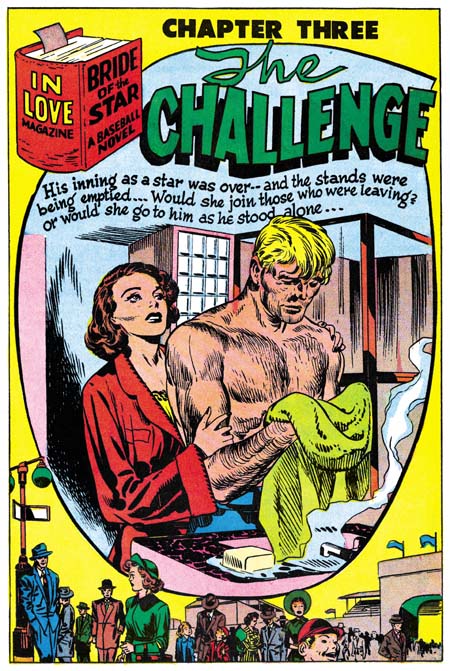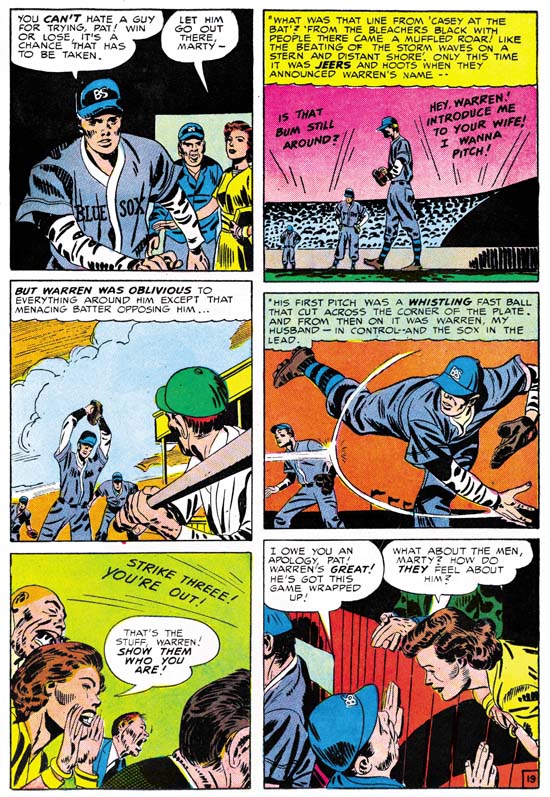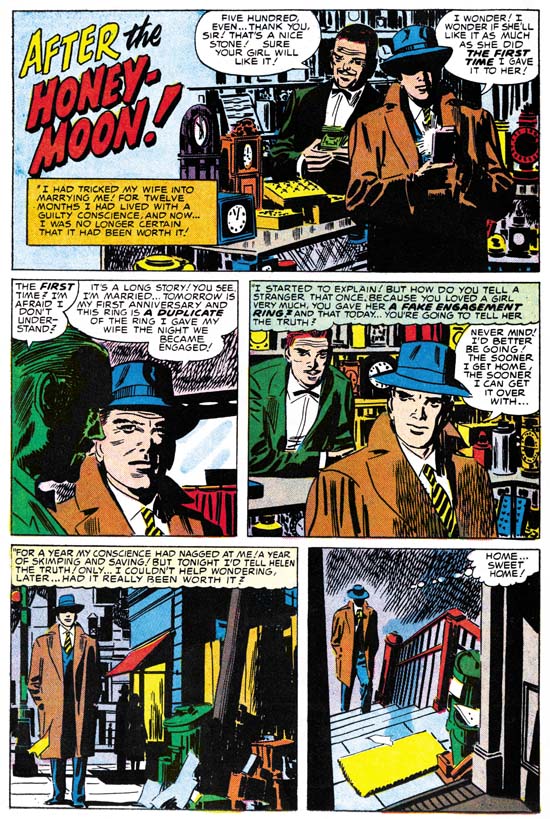
In Love #1 (September 1954) “Bride of the Star”, art by Jack Kirby
I have begun to scan and restore the Simon and Kirby title, In Love. By the time they published this title in 1954 under Mainline, their own company, Simon and Kirby had a long history of producing romance comics. In fact no one had a longer history because they had started the romance comic book genre (See my post The First Romance Comic). Joe and Jack wanted all the Mainline titles to be different and for In Love their hook was that it was a “book length love novel”. That claim was not completely accurate because besides the feature story the comic would contain a couple of short stories as well. But the feature would be, at least for the first few issues, longer then any other romance story that Simon and Kirby had ever produced. Long enough that they could divide it up into three chapters. The feature story for In Love #1 was “Bride of the Star” and was entirely drawn by Jack Kirby. I have already outlined the plot in the same First Romance post that I linked to above. But rather then ask the reader to read it from the link I have copied the appropriate paragraph:
A young lady nearly gets beaned with a baseball. This becomes the first meeting between the new rookie Warren and Patty, who just happens to be the daughter of the teams owner. Romance and then marriage follows. But having the father-in-law as the teams owner brings in difficulty. Warren insists in not getting special treatment. Betty stays home as the team travels and follows her husband’s progress, or lack thereof using newspapers. Warren is not doing well as a pitcher, wants to be sent back to the minors and resents that his special relationship with the owner is the only reason he hasn’t been. Eventually Warren leaves both baseball and Patty. Sometime later Warren returns to pick up his things. During a discussion with Patty, Warren wants to know if she still loves him. Patty says she wants to love him and it is not important that he is not a big star. But Warren has changed, before he wouldn’t accept defeat, now he was a quitter. Warren stays, the owner/father has a medical breakdown, and Warren helps Patty run the team. The team’s pitching staff all have injuries so Warren decides to step in and pitch. He declares he has kept himself in training. His pitching wins the game. Warren tells Patty that winning the game was not that important, it was winning her respect that mattered. Obviously their love has returned as the story ends with a kiss.

In Love #1 (September 1954) “Bride of the Star” page 19, art by Jack Kirby
Kirby’s romance stories generally have characteristics that make them unique from all stories by other artists that worked for the Simon and Kirby studio. Kirby emphasized action in his romance stories. This can be scene in “Bride of the Star” in the part that baseball plays. The story is a romance but on certain pages that can almost be missed because of the sport aspect.

In Love #1 (September 1954) “After the Honeymoon”, art by Mort Meskin
As mentioned above In Love would also include some short romances along with the feature story. One of these for In Love #1 was a two page tale drawn by Mort Meskin. Despite its short size it is a rather well executed story. In the first three panels (the splash is really part of the story) Meskin provides a conversation between a man and a merchant. Talking heads are always a problem in comics and particularly so for romances. Mort uses the contents of the store to keep the first and third panel interesting. For the second panel Meskin accomplishes this with the use of dramatic lighting on the merchant. Note in all three panels the main character faces us, normally in the depiction of a conversation you would expect one of the faces to be viewed from behind. This is exactly what happens in the second panel to the merchant. In the first panel Mort has the man turn about for a better light in which to view his purchase in the light. In the third panel although still conversing with the merchant, the man has already turned around to leave. In such a short story it is important to present the main character as much as possible to make a connection with the reader. Mort has done this rather well with such unobtrusive means. Because the story is so condensed, there is only a two panel bridge between the man’s dealings with the merchant and his meeting with his wife. Two panels are not much, but Mort manages to infuse them with necessary mood. After the preceding close-ups we are now presented with more distant view as the man as he walks alone. The night time is the proper setting for his troubled state. Pieces of paper blown by the wind are visual clues to the man’s unsettled thoughts. Beat up garbage pails reflect on the man’s unprosperous condition. The final panel uses a dramatic view from atop the steps, making the simple act of preparing to walk into his house as a struggle over the apprehension he has for the coming confrontation. The story, inspired by the short O’Henry tales, is one about the self sacrifice aspect of love.
Mort Meskin has manipulated the presentation of the story so well it is easy to miss what he has been doing. Mort’s drama is not the dynamic action that someone like Jack Kirby preferred. Rather Meskin works unobtrusively to set the proper emotional tone. Because it is so unassertive Mort’s efforts are often overlooked. I am not saying everything Meskin did was at this level, but it is not that unusual either. I previously examined on an even better story “The Dreaming Tower” in my post on Strange World of Your Dreams.
I like to believe that my studies of the comics produced by Simon and Kirby have given me an broad understanding of the last days of the Simon and Kirby studio. My views have not changed much from those I presented in my serial post The End of Simon and Kirby. Sure I would like to have more precise dates on some of the key events. I also admit that there is the possibility that I could be wrong in my interpretation of the data. Still I think I have an overall understanding of the relationship between Joe and Jack as well as some of the more important artists of their studio. However that understanding does not include Mort Meskin. Previously Mort played an important part in S&K productions. Mort significantly contributed to Boys’ Ranch, more then I think many realize. Yet when S&K launched Mainline that line included only three stories by Meskin, and all of those from the early issues. Bill Draut and John Prentice played much more important roles in Mainline titles, as did the newcomer Jo Albistur. Why did not Meskin show up more in Mainline? Mort’s presence in the Prize romance comics of this time did increase. But so did Draut, Prentice and Albistur due to Kirby’s absence. When Kirby returned to provide pretty much all the art for the Prize romance titles, Draut and Prentice show up in Harvey romances which at the time were being edited by Joe Simon. Why did not Meskin make that transition as well? I can think a number of possible explanations, but none that I can support with actual data. Mort Meskin’s relationship with Simon and Kirby during these times remains a bit of a mystery to me.


Harry,
Being both a Kirby and Baseball fan, the page you show makes me want to track down this issue and add it to my collection. Kirby captures the poses and energy of baseball on this page.
Meskin is great as well. Ditko stated he was a fan of his work and this page shows just how influenced he was by Meskin’s style. The pacing and mood is sensational.
Nick Caputo
Nick,
Joe is a big baseball fan. Was Jack?
Harry
I believe he was.
Mort Meskin started working for DC around the mid-fifties as well. They paid a lot better… and were very hard on him. I am guessing that his friends were happy for him that he had cracked the majors but it would also have taken a lot of his time. I don’t know how it influenced his presence at Prize and Mainline, but it could certainly explain his absence at the Simon edited Harvey books.
Ger,
I am not sure why Mort’s working for DC in the mid ’50s would have any affect on Meskin doing much work for Mainline. After all it did not affect his working on the S&K produced Prize romances at the same time. If Mort could work for DC and Prize romances at the same time, why would there be a problem of his working for Harvey a little later? Also why did Mort submit work to Prize’s All For Love, a title not produced by Simon and Kirby, in 1957? I am not saying there was not a connection between Mort’s DC work and his relationship with S&K, just that, like most possible explanations, I find it hard to back it up with any further evidence.
Harry
Harry,
You are right, it just might be a contributing factor to his leaving the studio. Because that is what I think happened. At some point he started working at home rather than at the studio. It may even be that the studio as such was abandonned when Jack and Joe started Mainline. You would probably know better than me.
Ger,
You have a good point that Mort probably left the S&K studio at the time he started working for DC. I do not think Joe or Jack would mind an artist working for other publishers, after all some of the artists that did work for them did work for other comics as well. But it is hard to believe that S&K would provide valuable studio space for an artist doing so much work for another company.
However most artist who worked for Joe and Jack did not do that work in the S&K studio. So Mort could have done so as well, and although he did not provide much work for the Mainline titles, he continued to do so for the S&K Prize romances that Joe and Jack still produced.
Harry